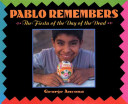by Julia López-Robertson, Julie Medlin and Casey Goldston, University of South Carolina
 This week two students offer a critique of the book and make connections to course readings in emergent bilingualism and linguistics. We begin with a summary, followed by the strengths and issues and close with teaching connections.
This week two students offer a critique of the book and make connections to course readings in emergent bilingualism and linguistics. We begin with a summary, followed by the strengths and issues and close with teaching connections.
Summary
Pablo Remembers: the Fiesta of the Day of the Dead, by George Ancona, is a chronological account of Pablo and his family in the three-day celebration of El Día del los Muertos, in Mexico. Starting with All Hallows Eve, then All Saints Day, and finally with Souls Day, Ancona follows the family’s preparations and activities for each day’s events. They travel to the market, prepare food, prepare altars, visit family, eat together, and visit the graves of loved ones.
Strengths
George Ancona’s real life photographs allows the reader to feel more connected to the people and better understand the action occurring each day in the celebration. The photographs produced a sense of realia by allowing the reading to see actual items associated with the holiday. Ancona also included italicized Spanish words with a glossary that allows a deeper understanding of the context—Mexico. Garcia and Kleifgen (2010) discuss the how using the first language to support comprehension is important to the literacy of those learners. The Spanish glossary may also play a role in preventing L1 language attrition, a phenomenon that Schmid (2009) and Pallier (2007) both document in their research. Students who have had no formal instruction in their L1 language get to read and understand L1 words, which may help slow the loss of the first language. Having read other books on El Día del los Muertos, we appreciated that this book explained that the holiday is in fact a three-day celebration and distinguishes the differences of each day. The photographs, glossary, and chronological format differentiate Pablo Remembers from other books; it is a useful text for elementary students to learn about this Mexican tradition.
Issues
On the other hand, the story as written is difficult to follow. The author shows many traditions via photographs and glossary terms, but offers a disjointed story to underscore the significance of the specific days during the three days celebration. Because of the author’s decision to focus on the foods and trappings, the ‘note from the author’ becomes a critical component for comprehending the text. Lorraine Wilson’s “Reading to live” (2002) challenges teachers to approach reading as “meaning making”. Activities associated with the reading assignment for this book must do more than just introduce new words. Teachers must design this reading activity in a way that allows the student to understand the meaning of the holiday – that they fully understand the meaning of the holiday AND the text. The way the text is written makes it hard for even the English speaker to understand important distinctions between the three days. In order to insure meaning transfer, the instructor must make sure that confusing components in the literature are underpinned by supportive exercises and activities.
Teaching connections
In teaching, it would be helpful to use the appendix as scaffolding for a comparison of other similar holidays to Day of the Dead. Campano (2007) encourages educators to embrace the diversity of the students represented in the classroom. He explains how doing so will connect home culture and language in such a way that encourages bilingualism and not suppresses it. We found this book to not fully explain the purpose of the holiday; the author answered what the day is but not the why the holiday exists. By incorporating the personal stories of the students in the classroom and the ‘note from the author’ these missing links can be filled for a fuller understanding of the holiday. Have you read the book? If so, what do you think?
References
Ancona, G., (1993). Pablo remembers: The fiesta of the day of the dead. New York: Lothrop, Lee & Shepard Books.
Campano, G., (2007). Immigrant students and literacy: Reading, writing, and remembering. New York: Teachers College Press.
Garcia, O. & Kleifgen, J. A., (2010). Educating emergent bilinguals: Policies, programs, and practices for English language learners. New York: Teachers College Press.
Pallier, C., (2007). Critical periods in language acquisition and language attrition. In Köpke et al. (eds.), 155-168.
Schmid, M. S., (2009). On L1 attrition and the linguistic system. EUROSLA Yearbook 9, 212-244.
Wilson, L., (2002). Reading to live. Portsmouth NH: Heinemann Publishing.
Journey through Worlds of Words during our open reading hours: Monday-Friday, 9 a.m. to 5 p.m. and Saturday, 9 a.m. to 1 p.m.
